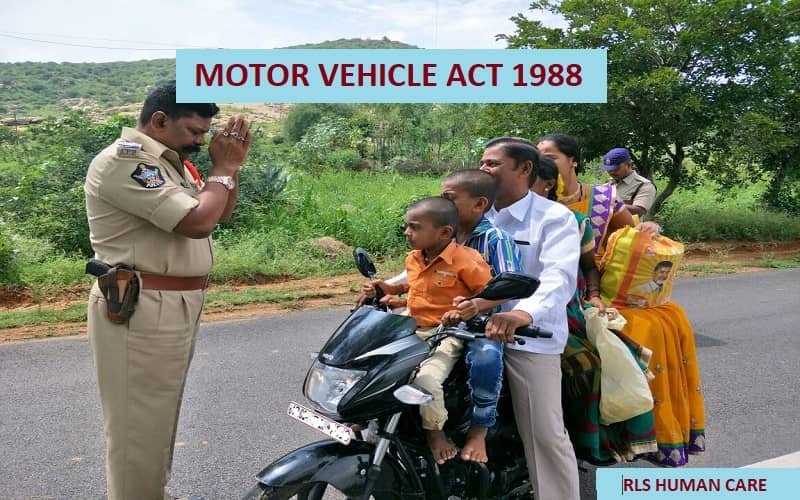Replacing of Act of 1939, this Act (59 of 1988) came into force from 1-7-1989. It was amended in 1994. It extends to the whole of India. It has 14 Chapters, 217 sections, and 2 schedules.
Statement of objects and Reasons
Contents
The 1994 Act inter alia provides for
- Definitions of the new type of vehicles.
- Simplification of procedure to grant a driving license.
- Restrictions on alteration of vehicles.
- Exemptions for non-polluting vehicles.
- Ceilings removed to curb
benami holdings. - States can appoint ST Appellate Tribunals.
- Punitive checks on substandard components and stocking/sale by the traders.
- Increase in compensation amount.
- Removal of
time limit forfilling claims. - Certain punishments made stringent.
New formula for compensation based on age income.- The Law Commission’s recommendation regarding the claim jurisdiction incorporated.
Definitions: In 49 definitions, new definitions of ‘manufacturer’ (of motor vehicles) and local authority as ST undertaking are added. Heavy goods
Motor vehicle or vehicle means any mechanically propelled vehicle adapted for use upon roads whether the power of propulsion is transmitted thereto from an external or internal source and includes chassis to which a body has not been attached and trailer, but does not include a vehicle running upon fixed rails or a vehicle of a special type adapted for use only in factory or any other enclosed premises or a vehicles having less than 4 wheels fitted with engine capacity of not exceeding 25 cc.
Licensing of Drivers (Chapter 2, Sec, 3 to 28): Motor vehicles act 1988

Without licence no person can drive a motor vehicle. Age limit require to drive amotor cycle of capacity less than 50 CC is 16 years, to drive a transport vehicle it is 20 years and in other cases it is 18 years. For breach the owner of the vehicle is responsible. The licence is non-transferable. (Section 3 to 7).
Procedure for application and grant of license is given u/s 8 to 11. Matters of licensing and regulation of driving schools are given in Sec. 12. The driving license is effective throughout India (Section 13). Renewal procedure is given u/s 15, revocation on the ground of disease or disability u/s 16 and appeals u/s 17. Grounds of disqualification (drunkard, addict, criminal, fraud or danger to the public) and revocation are given u/s 19.:Motor vehicles act 1988:Motor vehicles act 1988
| 1. | Learner’s licence | 6 Months. |
| 2. | 3 Years. | |
| 3. | License to the drive transport vehicle carrying dangerous | 1 Year. |
| 4. | Any other case | 20 years or age of 50 years whichever is erlier. |
| 5. | After the age of 50 years | 5nYears. |
| 6. | After the date of expiry of the licence | 1 Month. |
Motor vehicles act 1988
Other provisions are as under:
Power of Court disqualify – Section: 20
Suspension of driving license – Section: 21, 22
Effects of disqualification – Section: 23
Endorsement and transfer – Section: 24, 25
State Register of driving licenses – Section: 26
Rule making power of Central Goverment – Section: 27
Rule making power of State Goverment – Section: 28
Others:
Chapter-3: Licensing of Conductors.
Chapter-4: Registration of Motor vehicles.
Chapter-5: Control of Transport vehicles.
Chapter-6: ST undertaking.
Chapter-7: Construction, Equipment and Maintenance of motor vehicles.
Chapter-8: Control of Traffic.
Chapter-9: Vehicles temporarily leaving or visiting India.
Chapter-10: Liability without fault.
Chapter-11: Third party risk insurance
Chapter-12: Claims tribunals.
Chapter-13: Offenses, penalties and procedure.
Chapter-14: Miscellaneous.
Schedule-1: Traffic signs.
Schedule-2: Compensation for third party claims.
Control of the vehicle should remain effective. Right hand steering is required unless it is equipped with a mechanical or electrical signalling device of a prescribed nature (Section 109)

Central Goverment can make rules on the following matters: (Motor vehicles act 1988)
- Width, height, length, overhead of vehicles and loads to be carried.
- Size, nature, price, and condition of tyres and marking of date manufacture and maximum load carrying capacity.
- Brakes and steering gear.
- Safety glasses including prohibition of tinted safety glasses.
- Signalling appliances, lamps & reflector.
- Speed governors.
- Emission of smoke, visible vapour, sparks, ashes, grit or oil.
- Chassis number, engine number and date of manufacture.
- Safety belts, handle bars of motor cycles, auto dippers and other equipment essential for safety of drivers, passengers and other road users.
- Standards of components used as in-built safety devices.
- Transport of dangerous goods.
- Standard for emission of air pollutants.
- Installation of catalytic converters.
- Placement of audio-visual or radio or tape recorder etc. in public vehicles.
- Warranty after sale and norms therefore.
Exemption can be given subject to conditions (section 110).
State Goverments can make rules on the above matters and on the following matters also:
- Seating arrangements in public service vehicles and protection from
weather . - Prohibiting or restricting the use of audible signals at certain times or in certain places.
- Prohibiting the carrying of appliances to cause annoyance or danger.
- Periodical testing and inspection and fees to be charged.
- Use of trailers with motor vehicles.
- Particulars to be exhibited.
Control of Traffic (Chapter 8):
Motor vehicles act 1988
Following provisions are made:
- Limits of speed, maximum & minimum – Section:112.
- Limits of weight and use – Section:113.
- Requiring the vehicle to be weighed – Section:114.
- Restriction on use of vehicles – Section:115.
- Requiring erection of traffic signs – Section: 116.
- Parking places and halting stations – Section: 117.
- Driving regulations – Section: 118.
- Duty to obey traffic signs – Section: 119.
- No left hand driving in public place – Section: 120.
- Signals and signaling devices – Section: 121.
- Leaving vehicle in a dangerous position – Section: 122.
- Not to travel on running board, top bonnet or body of the vehicle – Section: 123.
- Prohibition to travel without pass or ticket – Section: 124.
- Obstruction of the driver – Section: 125.
- Stationary vehicles – Section: 126.
- Removal of vehicles abandoned or left on a public place – Section: 127.
- Safety measures for drivers and pillion riders. No driver will carry more than one person on a two-wheeler – Section: 128.
- Wearing helmet confirming to BIS Stantards, while driving the motorcycle. A Sikh’s is exempted – Section: 129.
- Duty to produce license and certificate of registration Police Officer in uniform can demand a driving license. RTO can demand insurance certificate, fitness certificate, permit and a conductor’s license – Section: 130.
- Precautions at unguarded railway level crossings. Ensure that no train or trolly is approaching from either side – Section: 131.
- Duty to stop in certain cases like an accident to a person, vehicle, property or animal (means horse, cattle, elephant, camel, ass, mule, sheep or goat) – Section: 132.
- The duty of owner to give information regarding driver to a police officer – Section:133.
- The duty of driver in case of accident and injury to a person. He will carry unless it is not practicable due to mob fury, the injured person to the nearest doctor or hospital who will immediately attend without waiting for any procedural formalities unless the injured person desires otherwise. He will also give information to the police officer and the insurer – Section: 134.
- The State Government can make schemes for investigation of accident cases and wayside amenities – Section: 135.
- Inspection of the vehicle involved in the accident – Section: 136.
- Rulemaking power of the Central Government – Section: 137.
- Rulemaking power of the State Government – Section: 138.





